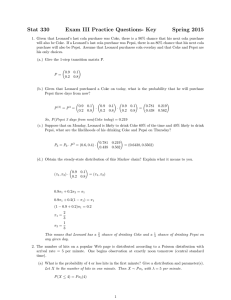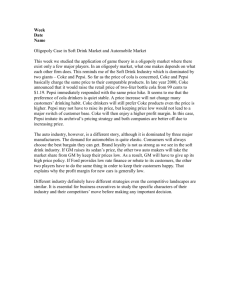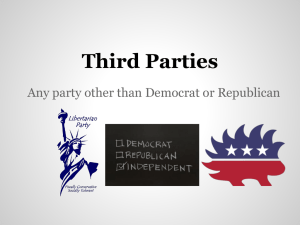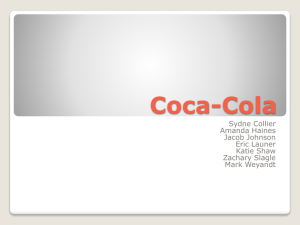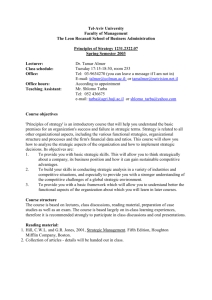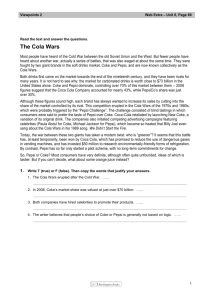Stat 330A Exam III Practice Questions Spring 2015
advertisement
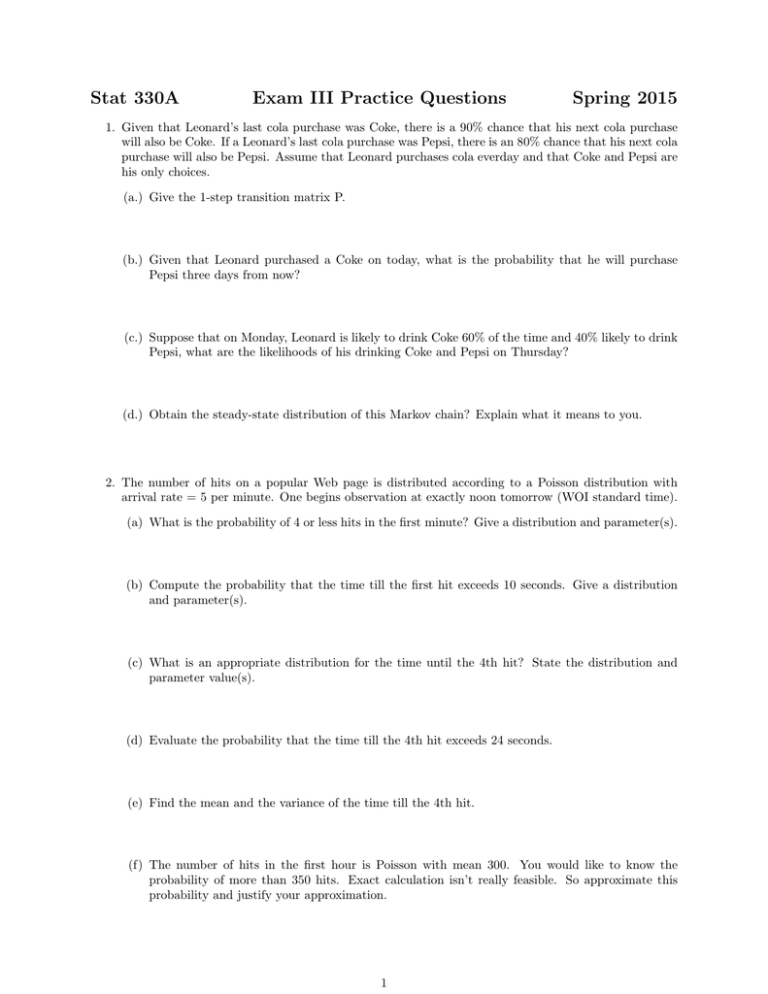
Stat 330A Exam III Practice Questions Spring 2015 1. Given that Leonard’s last cola purchase was Coke, there is a 90% chance that his next cola purchase will also be Coke. If a Leonard’s last cola purchase was Pepsi, there is an 80% chance that his next cola purchase will also be Pepsi. Assume that Leonard purchases cola everday and that Coke and Pepsi are his only choices. (a.) Give the 1-step transition matrix P. (b.) Given that Leonard purchased a Coke on today, what is the probability that he will purchase Pepsi three days from now? (c.) Suppose that on Monday, Leonard is likely to drink Coke 60% of the time and 40% likely to drink Pepsi, what are the likelihoods of his drinking Coke and Pepsi on Thursday? (d.) Obtain the steady-state distribution of this Markov chain? Explain what it means to you. 2. The number of hits on a popular Web page is distributed according to a Poisson distribution with arrival rate = 5 per minute. One begins observation at exactly noon tomorrow (WOI standard time). (a) What is the probability of 4 or less hits in the first minute? Give a distribution and parameter(s). (b) Compute the probability that the time till the first hit exceeds 10 seconds. Give a distribution and parameter(s). (c) What is an appropriate distribution for the time until the 4th hit? State the distribution and parameter value(s). (d) Evaluate the probability that the time till the 4th hit exceeds 24 seconds. (e) Find the mean and the variance of the time till the 4th hit. (f) The number of hits in the first hour is Poisson with mean 300. You would like to know the probability of more than 350 hits. Exact calculation isn’t really feasible. So approximate this probability and justify your approximation. 1 3. People arrive at a telephone booth at the Fly-by-Nite airline terminal in a random pattern with an average interarrival time of 12 minutes. The length of phone calls from the booth is exponentially distributed with an average time of 4 minutes. (a) What is the probability that an arriving person will have to wait? (b) What is the average length of waiting line that forms? (c) What is the probability that an arrival will have to wait for more than 10 minutes before the phone is available? (d) The telephone company plans to add an additional booth when the traffic increases so much that Wq ≥ 5 minutes. At what average interarrival time will Wq = 5 minutes occur? 4. A small Telemarketing Company has 4 telephones and 4 members of the staff answering calls. If all lines are busy, incoming callers are being told to call back later. Calls come in at a rate of 6 per min. Staff members need on average 30 seconds to answer a call. Assume that you are dealing with an M/M/x/y queuing system. If you are using any formulas from your notes, please specify which. (a) Draw a transition state diagram of the number of busy telephone lines. (b) Find the (steady state) probability that none of the lines is busy. (c) The manager of the telemarketing company is anxious that as few customers as possible should get a busy signal when calling. What is the rate of customers who are turned away? 2 5. A company has 4 software systems that periodically need the attention of a systems analyst. The company employs 3 analysts. Suppose that when operating, each system crashes (putting it out of operation) at rate λ = 2 per hour and that when working on a crashed system, an analyst returns it to working order (and back into operation) at rate µ = 1 per hour. (An analyst works on a single system at a time.) We wish to model this situation using a Birth and Death process with ”State i” being the situation ”i software systems are down.” (a) Sketch an appropriate state transition diagram (putting appropriate rates on it). (b) Find the (steady-state) probability p0 that none of the system analysts are busy. 6. A toll area on a highway has three toll booths. On the average cars arrive at the rate of one car every 6 seconds and joins a line. It takes 12 seconds to pay toll at any booth (not including waiting in the single line). (a) Find the (steady state) probability that there are no cars waiting or paying toll. (b) Find the (steady state) average number of cars in the line. (c) Find the average time of service. (5 points) (d) Find the (steady state) average number of cars in the line and paying toll. 3
